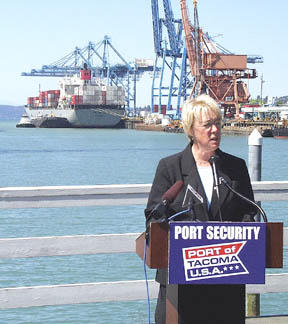Editors note: Dana Greenlees technology column, which normally runs in this space every Friday, will return next week. Sorry, all you disappointed technophiles.
She may be on a recess from Congress, but its no vacation for U.S. Sen. Patty Murray as she travels across Washington state during this time away from the nations capital.
Washington states senior Democratic senator – focusing on port security, jobs and economic development and workforce training – was in Tacoma Thursday for a morning-to-early afternoon tour of the city.
The highlight of Murrays visit was a stop at the Port of Tacoma, where she joined with port officials and maritime industry executives during a press conference to discuss Operation Safe Commerce, a port security initiative.
We want to know whats in these containers, where theyve been, where theyre going and whether theyve been tampered with, Murray said of the cargo that passes through the Port of Tacoma and other ports throughout the nation.
Millions of cargo containers enter Americas ports each year, Murray pointed out, a major concern since the Sept. 11, 2001, terrorist attacks.
Calling ports an important part of the countrys economic engine, Murray said a major terrorist strike on such installations could have a more devastating impact.
The Port of Tacoma supports 28,000 jobs in Pierce County and over 100,000 jobs in the state, Murray said.
Earlier this summer, Murray helped secure $27.5 million to help find the best ways to secure and monitor the cargo supply chains that serve the ports of Tacoma and Seattle.
Operation Safe Commerce is a federally funded program designed to provide a test-bed for new techniques to increase the security of container shipments – from the point of destination through the supply chain to the point of origin.
In addition to the Port of Tacoma/Seattle, the ports of Los Angeles/Long Beach and New York/New Jersey – the nations top three major load centers – will work with private and public entities to identify supply chain vulnerabilities and develop improved methods and technologies to ensure the security of cargo entering and leaving the nation.
Those security techniques that prove successful under the program will then be recommended for implementation throughout the maritime commerce industry.
Security has changed in last several years… noted Peter Bennett, vice president of Pacific region operations for K Line America, Inc., an integrated intermodal transportation company headquartered in Richmond, Va.
Shipping companies used to be concerned about people removing items from cargo containers, he said, but now the main worry is someone putting something in.
This is very important for us, Bennett said. We think this is important for the country.
Edward McCarthy, general manager for APM Terminals in Tacoma, agreed, calling security and safety a high priority for the global container terminal operator.
He said the company would work with all necessary government agencies to safeguard Americas ports.
Progress has been made, McCarthy said, but much work needs to be done.
This is just the beginning of heightening the security system at the Port of Tacoma, said Andrea Riniker, port executive director.
Things are happening now, Murray said, adding that she plans to ask for $30 million during the next fiscal year to expand security programs to other terminals. It was unclear if the Port of Tacoma will receive any more federal money. Were doing a lot better at our ports.
Murrays visit to Tacoma included stops at the Museum of Glass, Tacoma Art Museum and the WorkSource Center prior to coming to the Port of Tacoma.
Following the press conference at the Port of Tacoma, Murray met with University of Washington Tacoma Chancellor Vicki Carwein and toured the schools Institute of Technology facility. Murray also met with students to talk about their experiences in studying technology.





